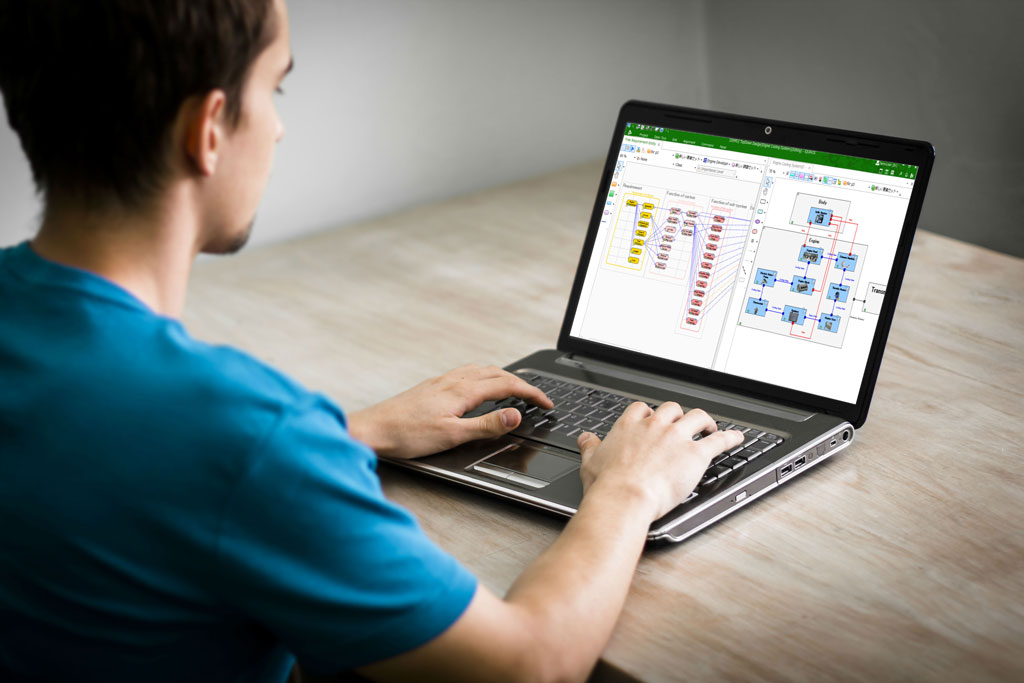What is iQUAVIS?
iQUAVIS is…
…. an intuitive software for product development
…. a tool for successful systems engineering
…. a tool for integrated project management
…. ideal for making your development projects even more successful
…. MBSE = Architecting + Project Management according to ISO/IEC 15288
Are you familiar with complex projects in product development, like punching machines, sorting systems, driverless transport systems, heat pumps, etc.?
Do you always have a complete and consistent overview of requirements, product architecture, features and your documents?
With iQUAVIS, the product development is based on the system architecture, which brings more transparency and more time for innovation. With an easy-to-conceive license structure.
iQUAVIS means more digitization for your company – in the phase of the project that is crucial for a digital twin, the smart factory or basic work according to lean principles.

Contact
What can you achieve with iQUAVIS?
Requirements management and product specification are considered in an integrated manner at iQUAVIS. This also enables early project management and quality management. iQUAVIS – this originally means QUAlity VISualisiation. Now it’s time for Systems Engineering!
Together with the Fraunhofer-Gesellschaft from Paderborn, iQUAVIS was developed into a real system engineering tool that uses MBSE models. It doesn’t matter whether it’s structure diagrams, behavioral diagrams or task planning. With this approach, you digitize the fuzzy frontend of product development.
- A common understanding of your projects brings success
- Simple and sustainable start into MBSE without SysML and complicated applications
- End-to-end traceability of requirements - functions - system elements - test cases
- Early detection of potential risks enables immediate correction
- Storage structure for your development documents - e.g. also as a link to the Sharepoint
- Assigning requirements to elements of a system
- Parallelization of development leads to acceleration of project durations
- Project structure and project scheduling, incl. easy customization
- Do you want to keep an eye on all your requirements at all times? Optimal resource allocation!
- Documentation from the very first moment creates a complete overview
Videos
You are currently viewing a placeholder content from YouTube. To access the actual content, click the button below. Please note that doing so will share data with third-party providers.
More InformationYou are currently viewing a placeholder content from YouTube. To access the actual content, click the button below. Please note that doing so will share data with third-party providers.
More InformationYou are currently viewing a placeholder content from YouTube. To access the actual content, click the button below. Please note that doing so will share data with third-party providers.
More InformationYou are currently viewing a placeholder content from YouTube. To access the actual content, click the button below. Please note that doing so will share data with third-party providers.
More InformationiQUAVIS - selected functions
iQUAVIS is a lightweight systems engineering platform that can be individually configured to meet your requirements. After a short training, you will be able to operate and configure the tool on your own! Of course, we accompany the entire MBSE implementation process and are still there for your questions, but our goal is for you to be able to work independently with iQUAVIS. From the multitude of functions, we present a few here.
You will learn everything about iQUAVIS and whether it is the right tool for your goals in a free initial consultation – we look forward to your inquiry!
iQUAVIS versions
A first look at the tool - iQUAVIS
The core of iQUAVIS is simple system modeling – without visible SysML. Just like in an Office application, you can model complex products easily and intuitively – without having to understand the depths of a complicated modeling language. The modelling of product hierarchies and product structures via trees – incl. of the necessary connections – also helps you with the setup and management of your project: use of resources, tracking of tasks, issue tracking and communication without detours via e-mails or Skype – directly in iQUAVIS! Block diagrams (e.g. environment or active structure) support the static description of the system, various behavior diagrams address the dynamic aspects. You work on a database and can use it to analyze the complex relationships in worksheets. A full-fledged project management incl. Connection to Microsoft Teams also makes iQUAVIS an agile tool.
